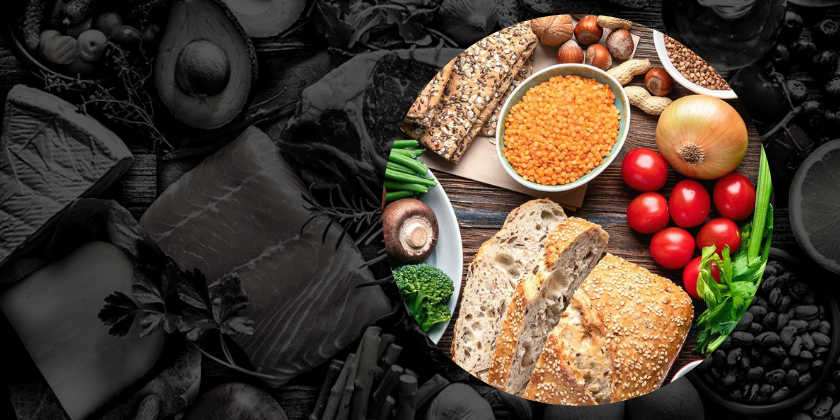
Have you ever found yourself scrolling social media or fitness websites and wondering what IIFYM means? Or maybe you know it means “if it fits your macros” … but you aren’t really sure what macros actually are. Consider this your overly simplified crash course.
Macros – short for macronutrients—are the three groups or categories of food that we consume the most: protein, carbohydrates, and fat. Most foods we eat contain one, two, or all three of these macronutrient groups, in varying amounts.
Protein. Protein fuels muscle synthesis, which means protein helps build muscle. Some examples of protein are chicken, fish, bone broth, egg whites.
Carbohydrates. Our body uses carbs for energy. White rice, pasta, bread.
Fats. Of the three macronutrients, fats are the most energy dense, which means that for a small amount, they have the most calories. Fats are used to balance hormone levels, regulate body temperature, can be used for energy, and many other vital functions. Think olive oil, butter, coconut oil.
So back to if it fits your macros. When someone (for example’s sake, we’ll call her Natalie) says this, she is presumably referring to her nutrition plan. Natalie’s nutrition plan has a certain amount of calories, set according to her age, height, activity level, goals, and several other factors. That set of overall calories is then broken down into a specific ratio of macronutrients, i.e. within that caloric total, Natalie is allotted a certain amount of protein, carbs, and fat. This breakdown or split can be different for everyone, because no two people are the same. Natalie’s diet might be 30% protein + 40% carbohydrate + 30% fat, whereas Wil might have a nutrition plan that looks more like 40% protein + 40% carbohydrate + 20% fat. Again, everyone’s nutrition can and should be highly individualized based on a number of factors (the biggest factors being that it is sustainable, incorporates the foods you love, and works for YOU).
How do you know how much protein, carb, or fat a food has? Thanks to technology, there’s a wonderful app called MyFitnessPal, or websites like calorieking.com that can provide you with more information than you ever wanted. Many restaurants also post their nutrition information on their websites.
Practical application. So when Natalie is at Federal Donuts on a Saturday morning and those hot fresh donuts are fresh out of the oven … she might ask herself if a donut fits her macros, i.e. does it fit into her nutrition plan. Translation: what is the macronutrient breakdown of this donut (how much protein, carb, and fat does it contain), and does her nutrition plan give her enough grams of protein, carbs, and fats to allow her to consume said hot fresh donut while still adhering to her plan? With just a little bit of planning … the answer is might actually be yes. YES, the hot fresh donut DOES fit Natalie’s macros [jumps for joy, adds IIFYM gif to Instagram Story]. Natalie knew she wanted that donut on Saturday morning, so she checked the nutrition information online the night before, entered it into MyFitnessPal, and restructured the rest of her Saturday meals to account for the donut. And for what it is worth, she enjoyed every bite and had no regrets.
It is worth restating that this is an overly simplified look at macronutrients. There is a lot more nuance to nutrition. We can discuss the macronutrient composition of peanut butter (it has protein, carbohydrates, AND fat) or hormone balance, but that is for another blog. Or for a discussion with me, because I absolutely love to geek out about nutrition. Hungry for more (see what I did there)? Please don’t be shy and reach out!
Fearless Eating Challenge
There’s no recipe this week. Instead, the challenge is to put a meal together that contains:
- 1 palm-size portion of protein
- 1-2 cupped hand-size portions of carbohydrate
- 1-2 thumb-size portions of fat
BONUS:
See how many colors of the rainbow you can include in your meal. The more, the merrier.
Example:
- 3.5 oz grilled chicken breast (protein)
- Handful of grape tomatoes (carb)
- Half a sweet potato (carb) roasted in ½ tbsp extra virgin olive oil (fat)
- 10 almonds
- All served on a bed of romaine lettuce (carb)
- ½ tbsp extra virgin olive oil (as salad dressing)
Macronutrient breakdown (P/C/F):
- 3.5 oz grilled chicken breast = 31 P/0 C/4 F
- 3.5 oz grape tomatoes = 1 P/2 C/0 F
- 200g sweet potato = 3 P/40 C/0 F
- 1 tbsp extra virgin olive oil = 0 P/0 C/14 F
- 10 almonds = 3 P/2 C/6 F
- 2 cups Romaine lettuce = 1 P/3 C/0 F
Total macros for this meal =
- Protein: 39 grams
- Carbs: 47 grams
- Fat: 24 grams
This meal achieves a few things:
- Lean protein
- Whole, unprocessed food (nothing packaged or made in a factory)
- Lots of colors
- Quick and easy!
Fearless Listening
If you’d like to learn more about nutrition, but aren’t sure where to start, check out EC Synkowski’s 10 Principles of Nutrition. EC does a great job breaking down the science of nutrition into digestible (I did it again), actionable concepts, as well as debunking common diet myths. Her podcast The Consistency Project inspires some great conversation and discussion of her 10 Principles.
Written by: Coach Natalie Lewis









